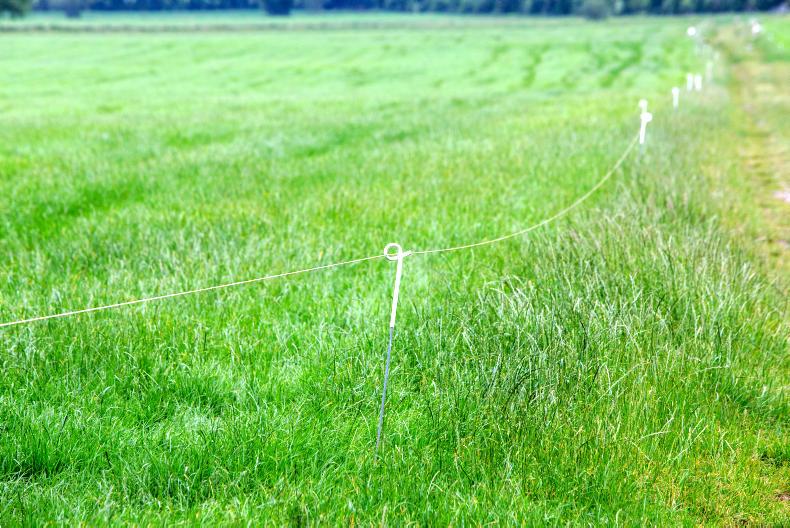Whenever Met Eireann issue warnings about the spread of potato blight we can expect a lift in grass growth.
The warm, muggy and wet conditions that are conducive to the spread of blight are also very conducive to grass growth.
Combined with the fact that there would already be some level of compensatory growth after the recent dry spell, I think many farmers can expect to grow over 100kg/day for a number of days this week.
However, this growth rate won’t be consistent across the country. Farmers that got their first lot of heavy rain towards the end of last week will be slower to emerge from the drought.
This is particularly evident where average farm cover is depleted at less than 500kg/ha. It takes a good bit of time for grass to come back and it’s not until covers go above 600kg/ha that they really start to grow fast.
Drought recovery
Farmers that are in drought recovery will need to continue to supplement their herds until such time as average farm cover is back to near normal levels of about 150kg to 160kg per cow.
This is difficult to do, especially in wet weather but it’s important not to take the foot off the brakes just yet.
Those that have been getting rain for over a week now will be the ones that will experience the highest growth rates.
This is because average farm cover has more or less recovered, soil moisture deficits are not an issue and there are some reasonable high covers in many paddocks.
A burst in growth this week will lead to an accumulation of stem in many paddocks which is not good news from a grass quality perspective.
A burst in growth this week will lead to an accumulation of stem in many paddocks which is not good news from a grass quality perspective.
Farmers will need to be extra vigilant for quality and must be prepared to skip over paddocks for silage if covers get too strong or if there is too much stem in the sward. However, it looks like there will be limited chances to take out paddocks for silage this week.
Another key decision this week will be around supplement use. With growth rates good and most farms back to normal in terms of average farm cover, it doesn’t make any sense to be feeding a high level of supplement.
However, if considering removing supplement completely, do so over the period of a few days and keep an eye out for signs of grass tetany or prevent it in other ways such as paddock dusting or through the water. There could be tetany weather this week.
Read more
New Zealand moves to cap bag nitrogen
The Grass Week: rain on the way
Whenever Met Eireann issue warnings about the spread of potato blight we can expect a lift in grass growth.
The warm, muggy and wet conditions that are conducive to the spread of blight are also very conducive to grass growth.
Combined with the fact that there would already be some level of compensatory growth after the recent dry spell, I think many farmers can expect to grow over 100kg/day for a number of days this week.
However, this growth rate won’t be consistent across the country. Farmers that got their first lot of heavy rain towards the end of last week will be slower to emerge from the drought.
This is particularly evident where average farm cover is depleted at less than 500kg/ha. It takes a good bit of time for grass to come back and it’s not until covers go above 600kg/ha that they really start to grow fast.
Drought recovery
Farmers that are in drought recovery will need to continue to supplement their herds until such time as average farm cover is back to near normal levels of about 150kg to 160kg per cow.
This is difficult to do, especially in wet weather but it’s important not to take the foot off the brakes just yet.
Those that have been getting rain for over a week now will be the ones that will experience the highest growth rates.
This is because average farm cover has more or less recovered, soil moisture deficits are not an issue and there are some reasonable high covers in many paddocks.
A burst in growth this week will lead to an accumulation of stem in many paddocks which is not good news from a grass quality perspective.
A burst in growth this week will lead to an accumulation of stem in many paddocks which is not good news from a grass quality perspective.
Farmers will need to be extra vigilant for quality and must be prepared to skip over paddocks for silage if covers get too strong or if there is too much stem in the sward. However, it looks like there will be limited chances to take out paddocks for silage this week.
Another key decision this week will be around supplement use. With growth rates good and most farms back to normal in terms of average farm cover, it doesn’t make any sense to be feeding a high level of supplement.
However, if considering removing supplement completely, do so over the period of a few days and keep an eye out for signs of grass tetany or prevent it in other ways such as paddock dusting or through the water. There could be tetany weather this week.
Read more
New Zealand moves to cap bag nitrogen
The Grass Week: rain on the way






 This is a subscriber-only article
This is a subscriber-only article











SHARING OPTIONS: